I stumbled upon a 2022 Kimber print catalog in a gun store in August of 2021- the K6xs was on the cover. I grabbed a copy and ran from the store whooping and cackling in a most unprofessional manner. I immediately texted a picture of it to Mike, wanting to share my excitement for the imminent arrival of this gun. It took a bit longer than expected, but the K6xs finally began to ship in the summer of 2023.
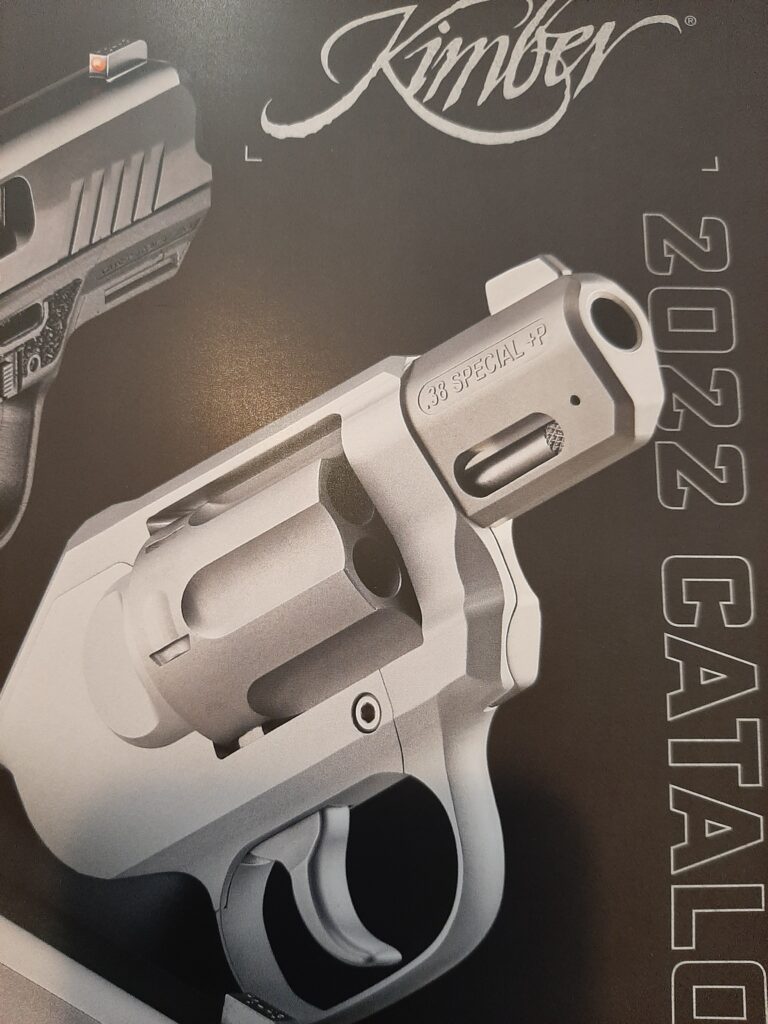
The K6xs is a return to the snub-nosed carry revolver in its purest form. It’s an alloy framed .38 Special revolver with a six -shot cylinder, two-inch barrel, and internal hammer. The K6xs travels light but stays true to Kimber’s vision of what a revolver should be.
A Little Background
Kimber introduced its K6 revolver in 2016; it was an unexpected departure from its quality bolt guns and semiautomatic pistols. Kimber’s engineers listened closely to input from experienced folks in the industry (like Grant Cunningham) to establish their build parameters. Key among those were six shot capacity, a smooth trigger, and good sights- on a gun that would fit in a J frame sized box. The .357 Magnum chambered K6 met those requirements and was immediately successful.
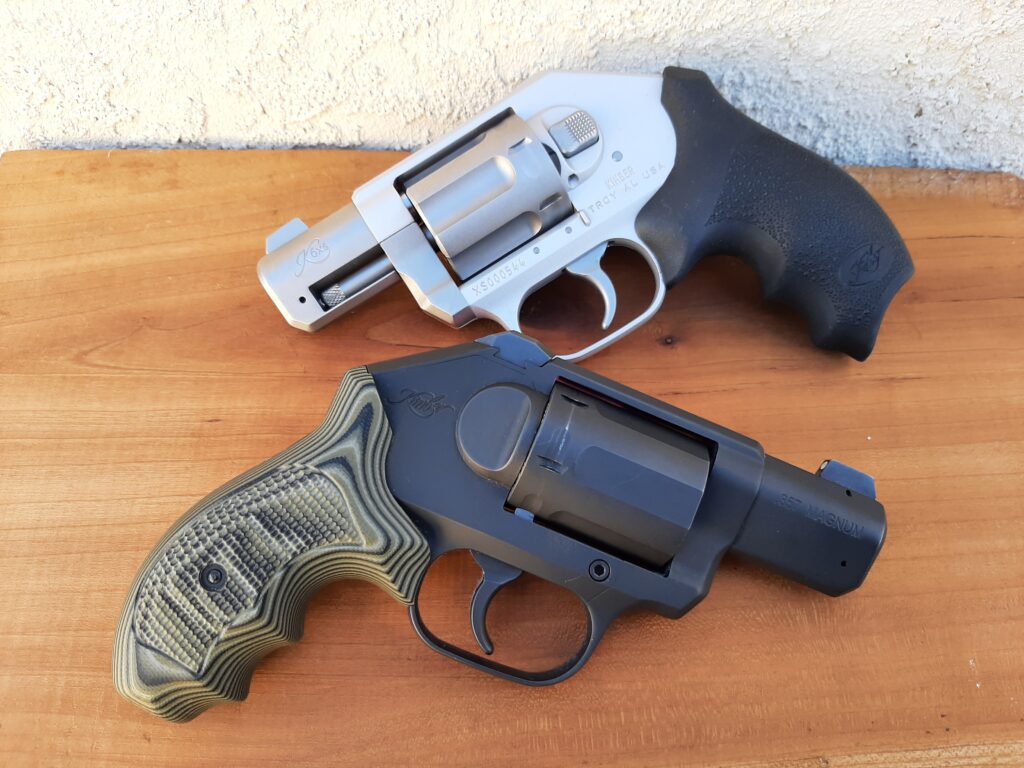
A three-inch barreled version of the stainless-steel gun was soon available, followed by variants with external hammers. There is now a K6 offered with adjustable sights and a four-inch barrel; this configuration basically bumps the gun into service revolver size territory. Since its release, the K6 has been exceptionally well covered here at RG by Justin and Mike; I bought one in 2019 based largely on their coverage. It has been one of my most carried revolvers since.
First Impressions
I have had the good fortune to handle and fire two test samples of the K6xs of late. The fit and finish of both have been excellent. The silver “Kim Pro II” finish on the alloy frame contrasts slightly with the bead blasted stainless steel barrel and cylinder. The badging on the gun is minimal and in good taste.
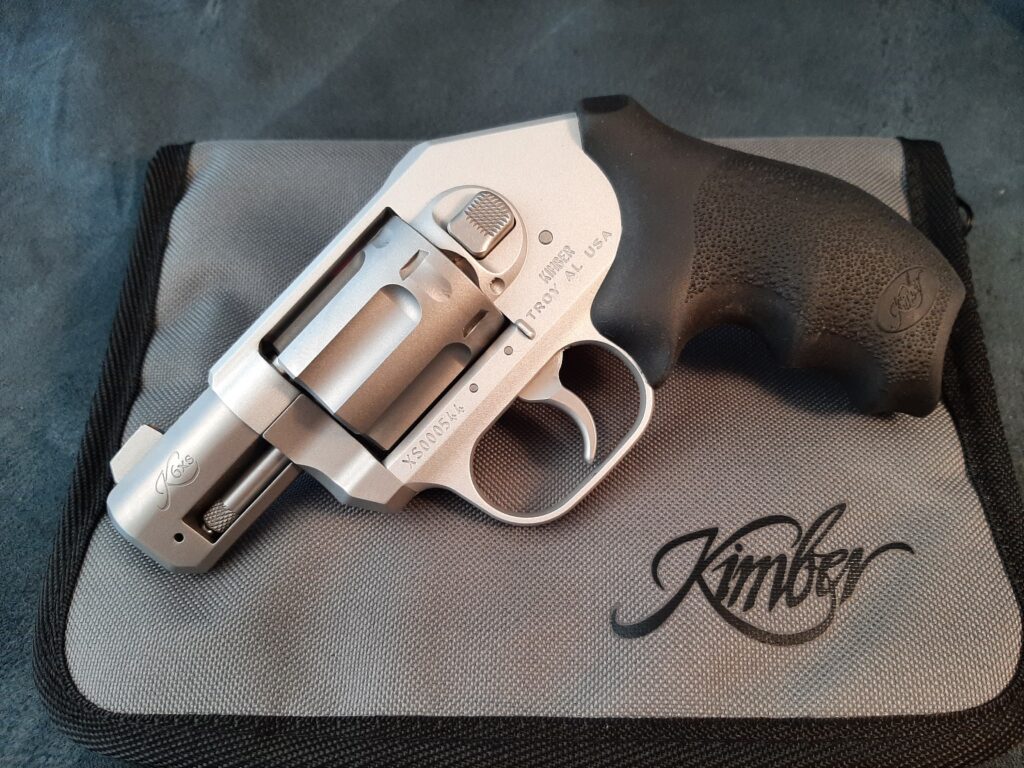
The model number adorns the left side of the barrel, the chambering is etched on the right side. The serial number is engraved on the left side of the frame below the cylinder window. The city, state, and country of manufacture are documented below the cylinder release (Troy AL USA). Kimber’s logo is featured on the opposite side plate.
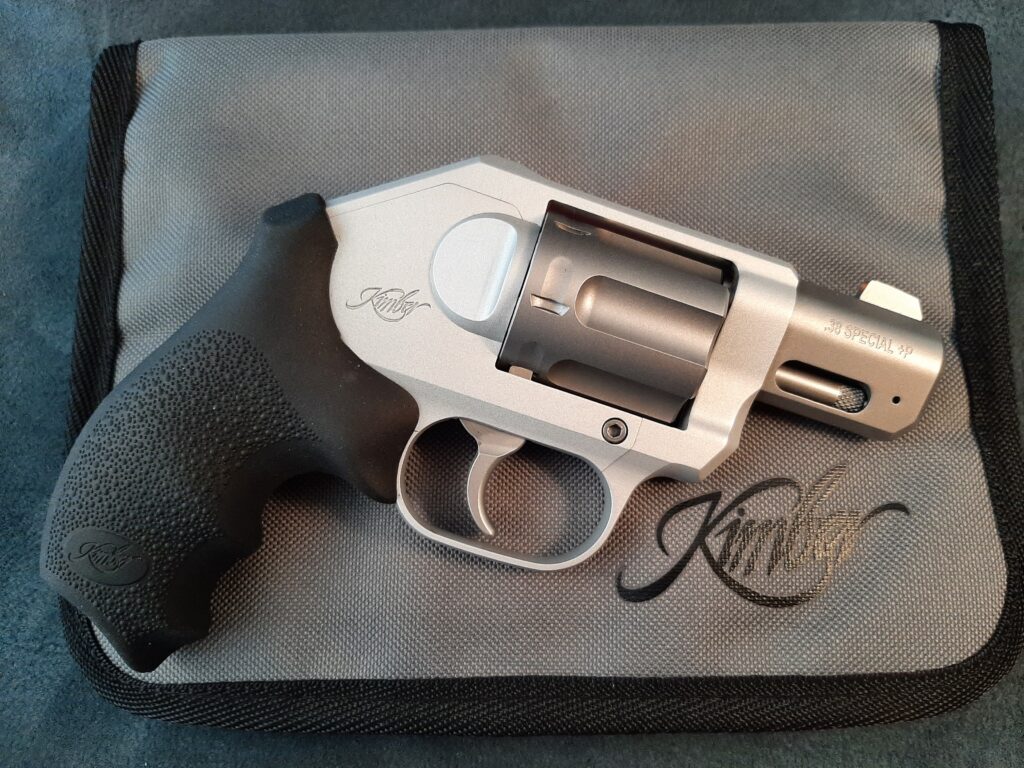
Instead of the flats we are accustomed to seeing on the exterior of the K6’s cylinder, the K6xs features deep, wide flutes. The front edge of the cylinder has a slight chamfer. The barrel underlug has a relief cut on the right side that exposes the extractor rod to view and shaves a little weight.
Unlike the original K6 design, the K6xs features a fixed front sight milled from the barrel. It is .220” tall and the face is slightly ramped, maintaining the excellent profile of the K6 front sight.
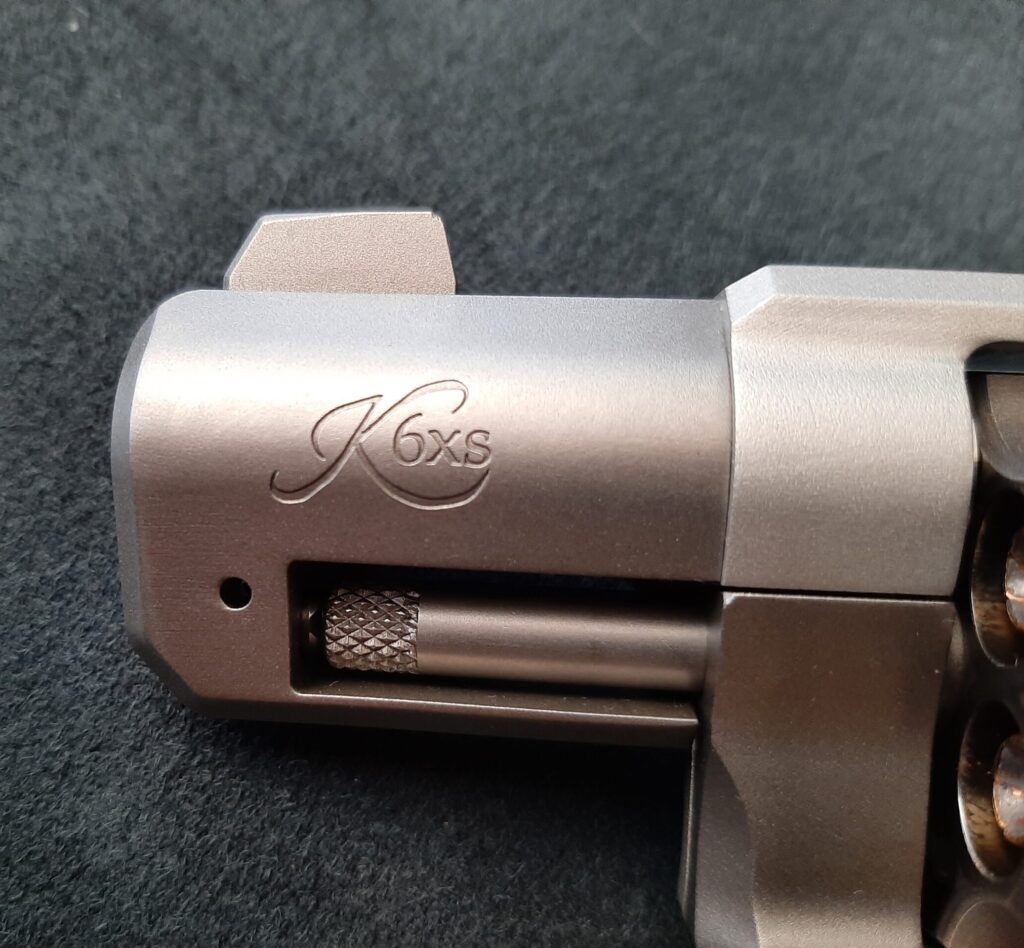
The dull stainless sight has a painted orange dot to draw the eye. The rear sight is a trench cut into the alloy frame like on most compact revolvers. The top of the frame is built up slightly at the back edge just before it angles down towards the grips. This build-up allows enough material to make the rear sight window nicely deep. The notch is cut wide enough to allow some daylight on either side of the front sight. The shape and dimensions of the sights are superior to any fixed sights I have seen on a small revolver.
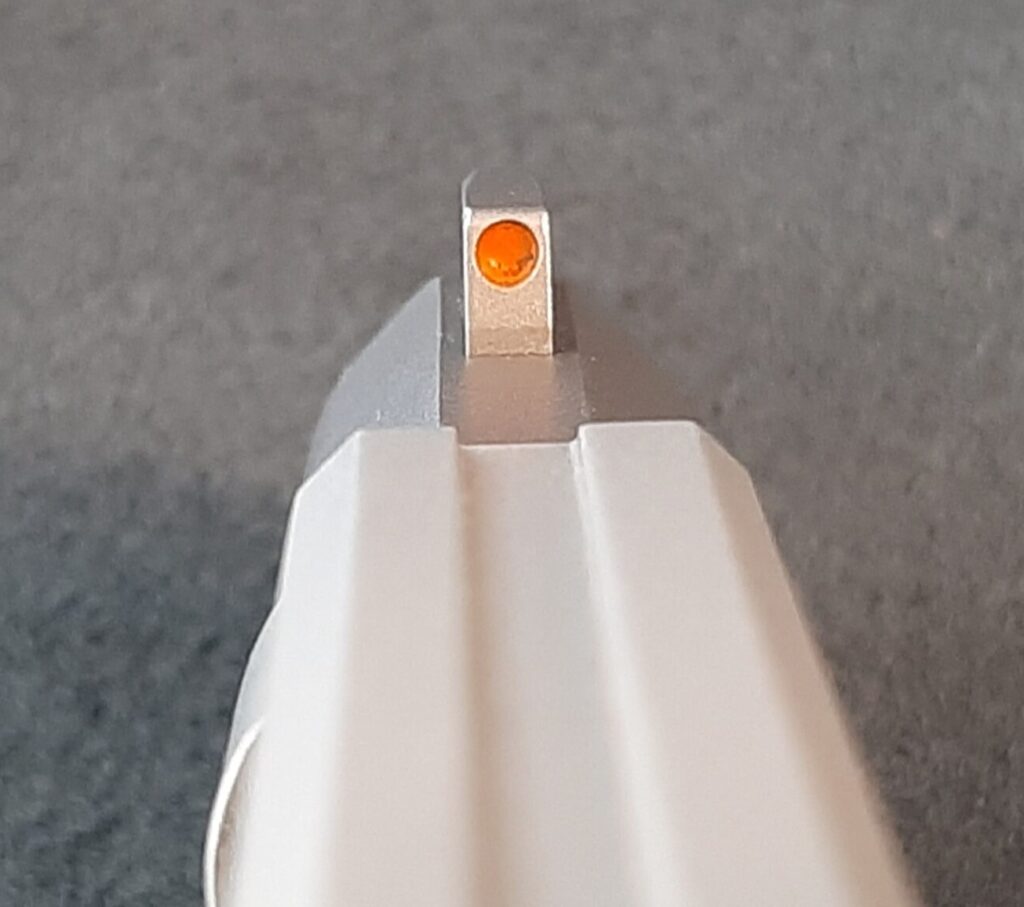
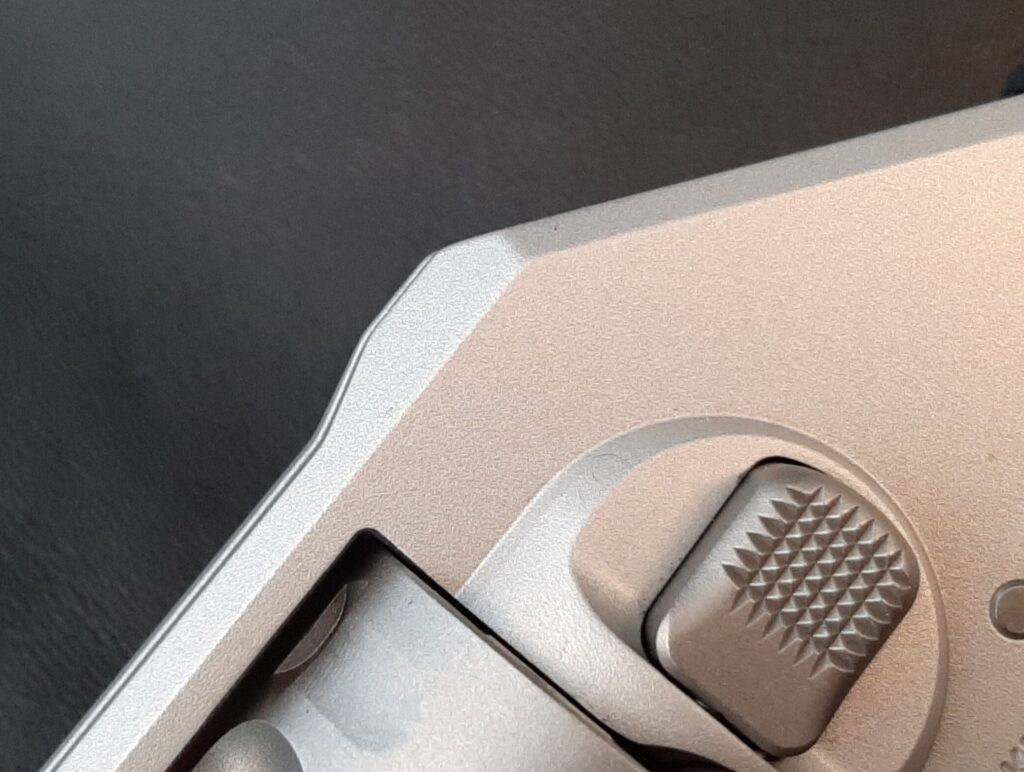
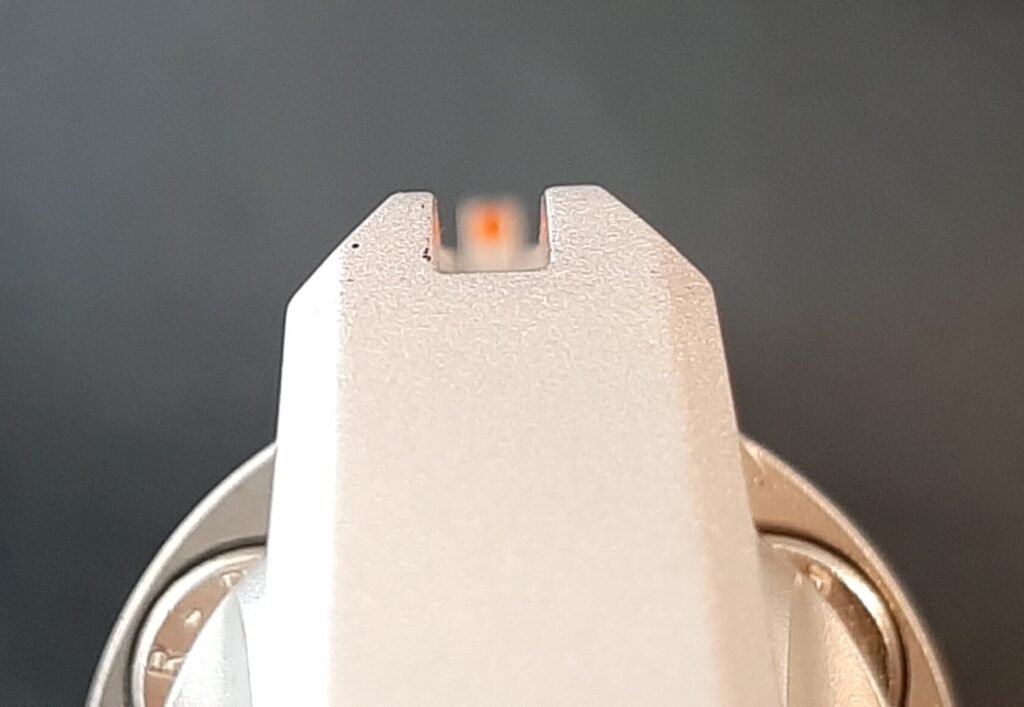
Ergonomics
The K6xs advertises a weight of 15.9 ounces, it weighed 15.6 ounces empty on my scale. This is a significant reduction from the Magnum K6 that starts at 23 ounces and goes up from there. It comes equipped with Hogue Bantam rubber grips. These offer a good compromise between being concealable and still giving some cushion against recoil. The front of the grip extends below the frame about ½ an inch, allowing a third finger groove and should permit most shooters to get all three support fingers involved in the grasp.
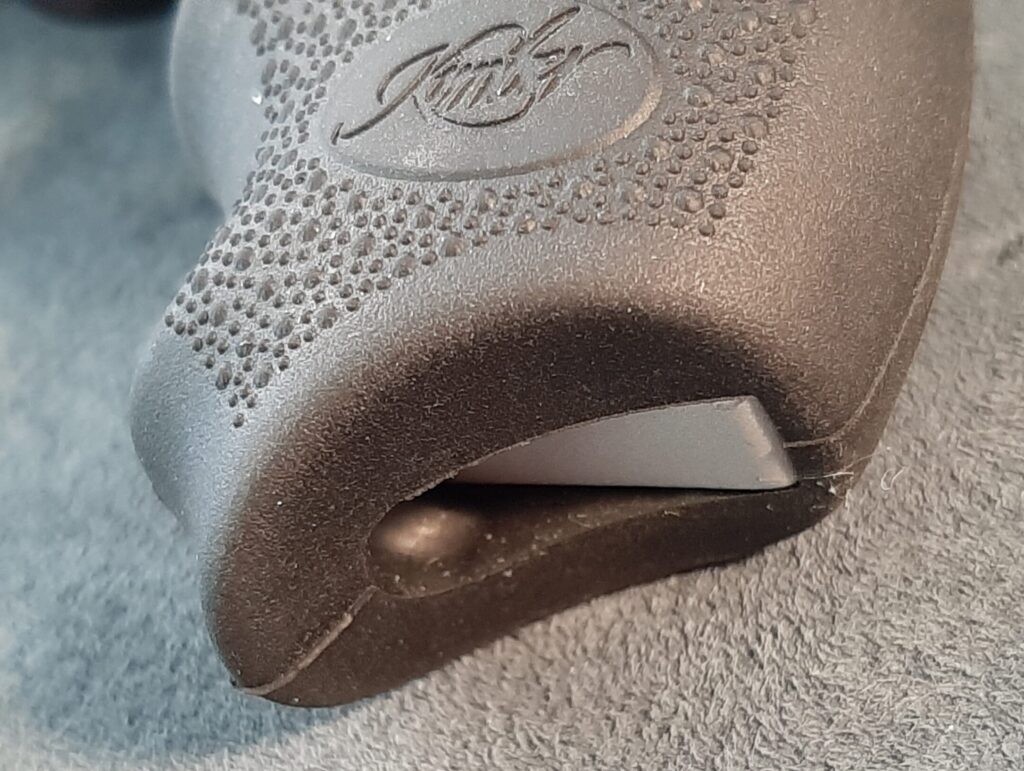
The back of the grip completely covers the backstrap and stops even with the bottom of the frame. The sides of the grips have molded in “pebbles” for traction in the hand. These grips favor shooter comfort over pure concealment. If you plan on shooting the gun often, the Hogues make sense. There are grips available for the K6 that are more concealable if the mission so dictates, but these hide adequately.
The cylinder release is identical in function to the Magnum K6, inward pressure releases the cylinder to open. Kimber’s design is well done- there are no sharp edges, and it won’t bark a knuckle during recoil. Curiously, both K6xs releases are noticeably stiffer to operate than my .357 K6. Once the cylinder is released, it spins freely and smoothly on the yoke. The trigger appears to be the same one used in the original, it’s smooth faced and of “combat” width. The trigger pull is good; I can detect no difference in comparing it to my K6, even though mine has several hundred rounds (and several hundred dry fire strokes) logged. It averaged 10.25 pounds on a Lyman Gauge. The extractor rod maintains the outstanding length of throw as the original K6, about .855”. Like on the S&W design, the extractor rod is an integral part of locking the cylinder. The front of the rod engages the locking bolt when the cylinder is closed. The front edge of the K6xs extractor rod is nicely smoothed and radiused above the knurled end. This is a thoughtful touch which keeps the tip from drawing blood when smacking it with a palm to eject empties positively.
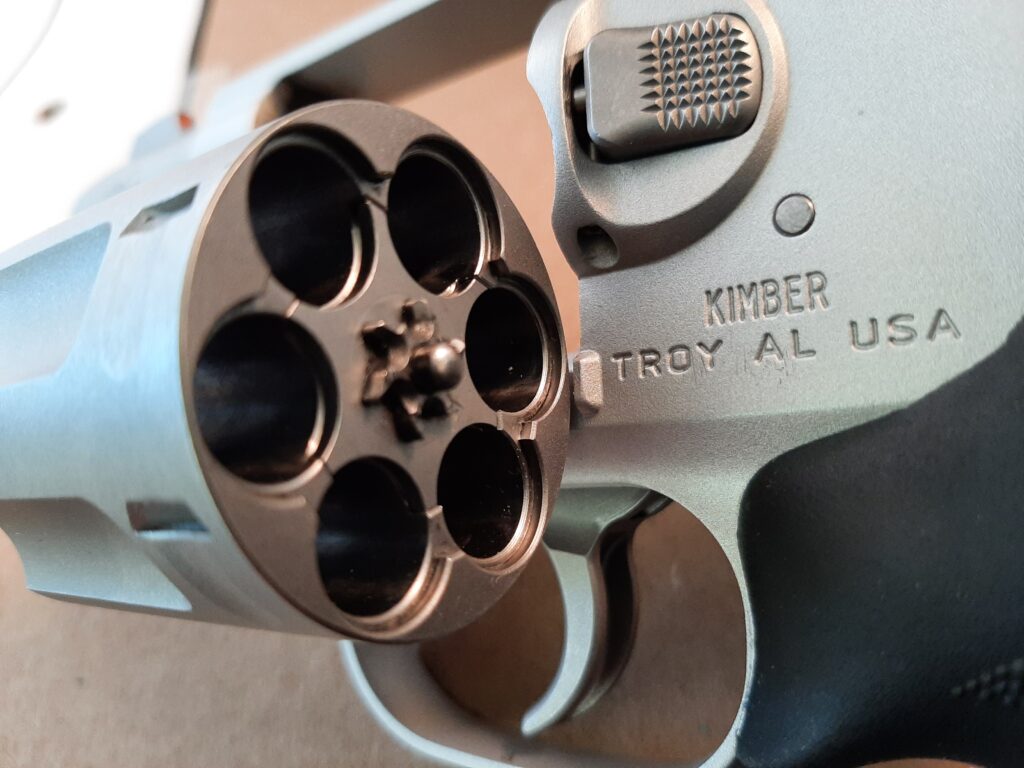
Handling the revolver revealed a few other noteworthy features. When the trigger was pressed and held to the rear, the lock up provided by the cylinder stop was rock solid. Like all Kimber revolvers, the chambers on the K6xs are countersunk. The chamber bodies are much smoother than on my K6. Combined with the countersink, it felt like the gun had a custom charge hole chamfer when loading cartridges into the cylinder. This was beneficial regardless of whether the rounds were coming from a speedloader, a strip, or loaded loose.
Live Fire
I fired 160 rounds through a K6xs in August, gathering chronograph data for another article I was writing about the gun. 75 rounds of this total were +P. Most of the shooting was slow fire from a rest. I was exceedingly pleased to discover that the sights were better regulated for contemporary weights of .38 +P defensive ammunition. The gun shot to vertical point of aim with bullets weighing 110-125 grains. 130-158 grain projectiles impacted higher than point of aim at 7-10 yards.
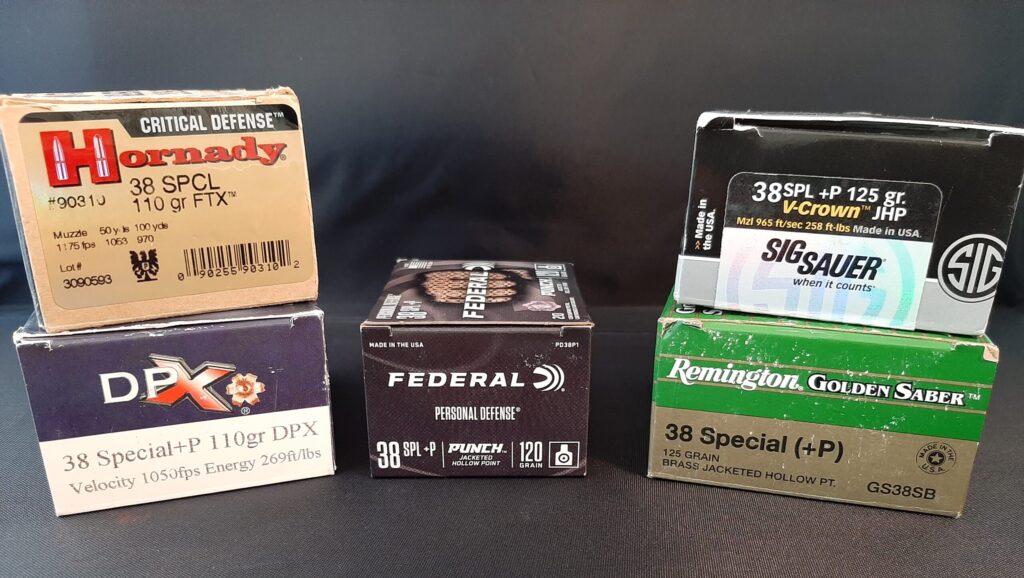
The recoil from the lightweight K6xs was not an issue. Oddly, the tip of my trigger finger became sore shortly after surpassing the 100-round mark. It reminded me of the discomfort experienced from shooting lots of rounds through a Glock pistol, dragging my trigger finger on the trigger guard from contacting the trigger too low. The groups fired that day were impacting slightly right of center, too.
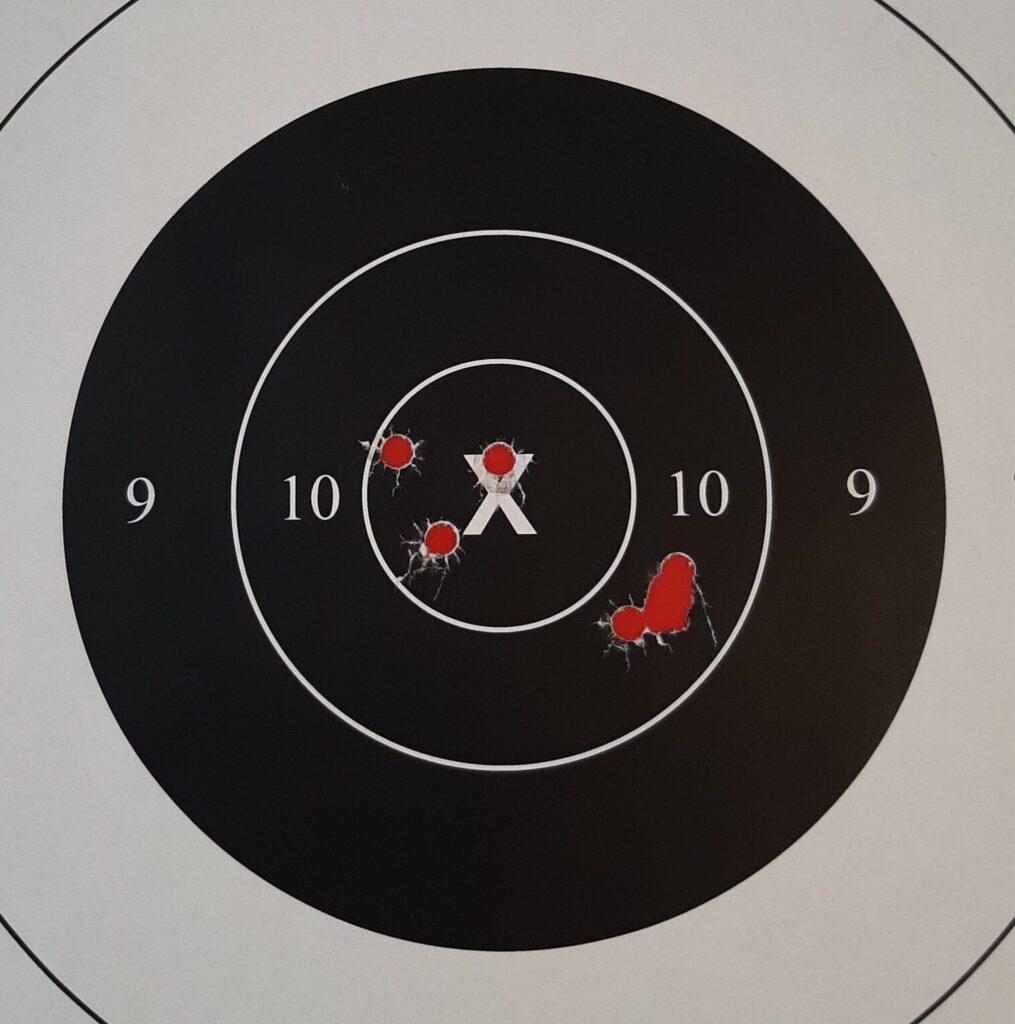
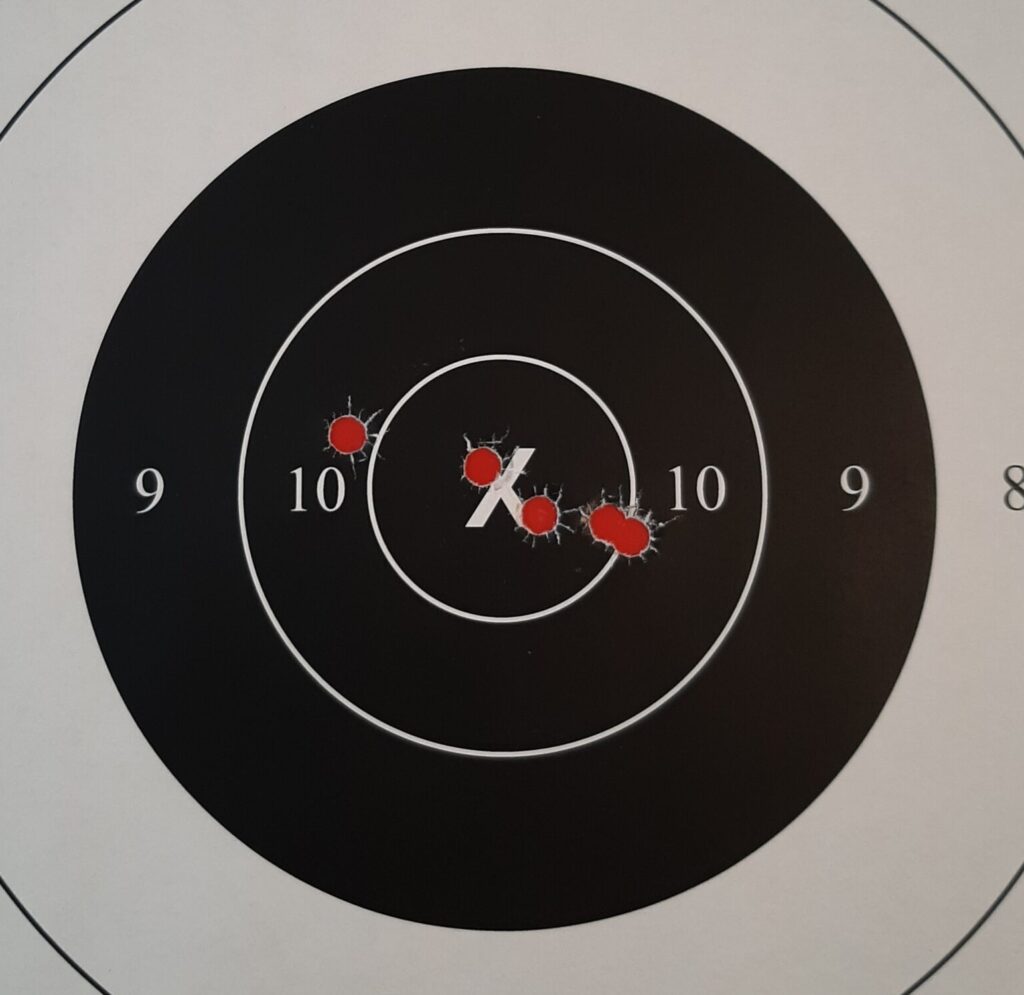
My next trip out was with the K6xs that Kimber had sent for RG testing. I did no rested shooting and didn’t experience the trigger finger soreness that occurred the first time while firing everything slowly, trying to eek out the best groups possible. This one also shot to the sights with lighter bullets and groups were more centered windage wise. I believe this was because I was shooting unsupported and rolling through the trigger smoothly.
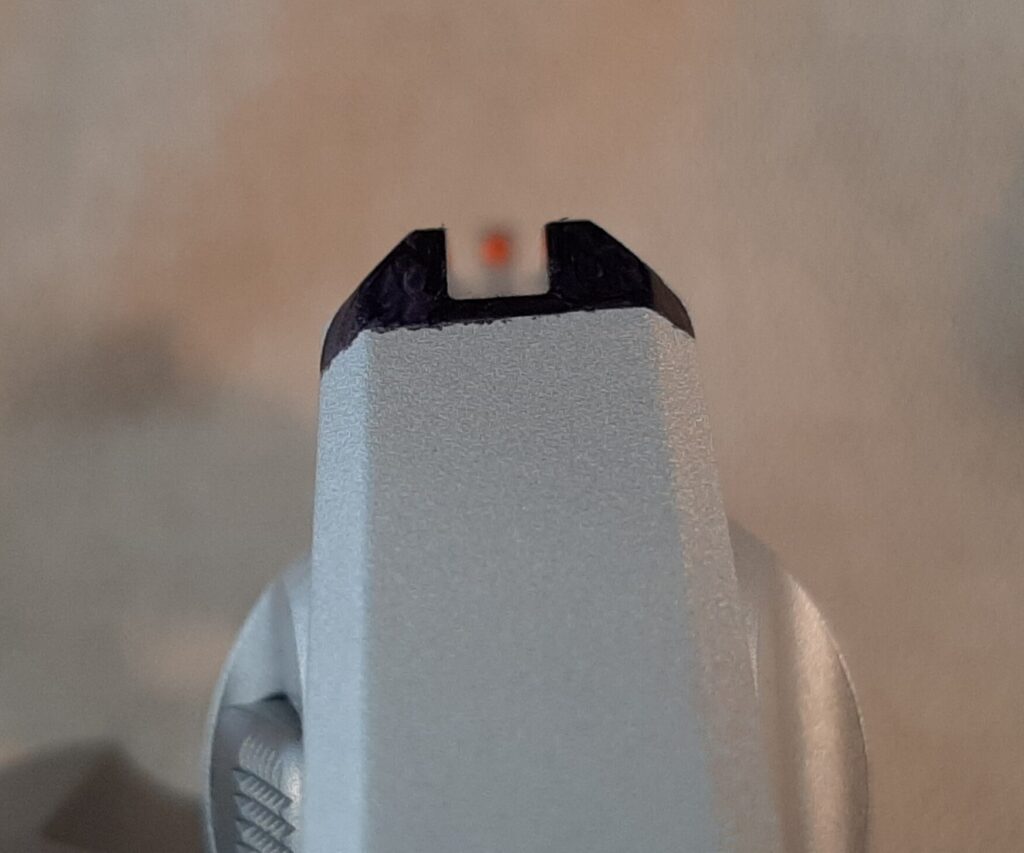
Shooting on targets with a lighter background than B-8 centers revealed the tendency of the silver rear sight to wash out to varying degrees. I darkened it with a black sharpie and the contrast with the silver front sight was easier to pick up regardless of the background. I fired 100 rounds through the K6xs that day.
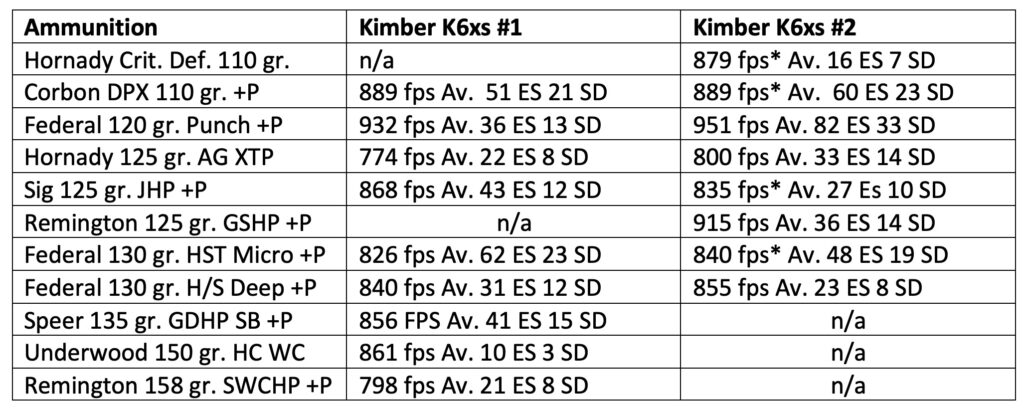
Most velocities were captured at temperatures of 73-85 degrees Fahrenheit. The temperature was 38 degrees when the four velocities designated with the asterisk were measured (There was a long break between shooting sessions and winter was upon us before I finally made it back out).
In the cold, I ran Hardwired Tactical’s “Super Snubby Test” with the Kimber. I shot it clean and made time on the first two stages but went slightly over the 3.5 second limit on the strong hand only stage (4.33 sec). Repeating just that stage resulted in a 3.18 second time, dropping one round into the 9 ring at 4 o’clock. Shaking off some rust, my time was faster on a second attempt, but a little accuracy was sacrificed- finishing with a 146/150.
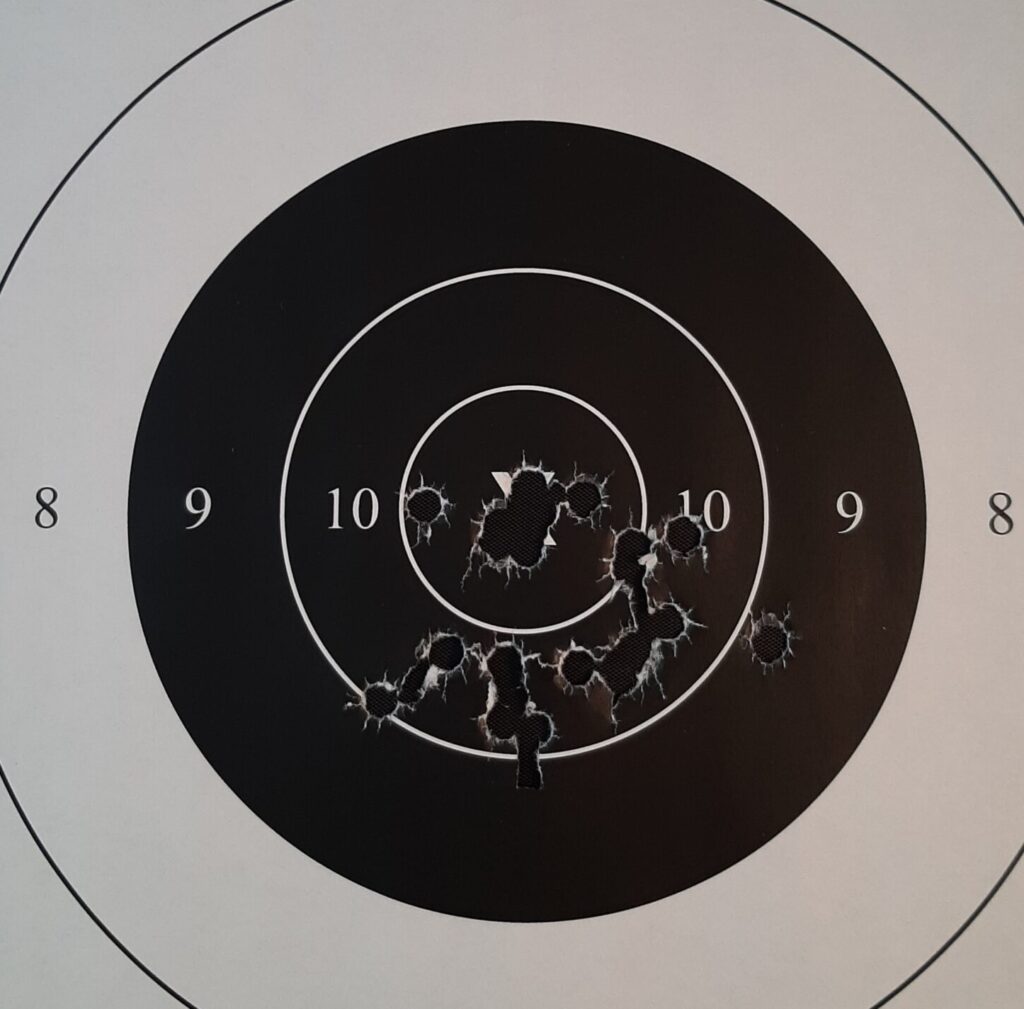
I then ran a snubby modified version of “The Test,” developed by Ken Hackathorn. Six rounds in six seconds from a low ready at 7 yards. The first try found me a little tardy, keeping all hits in the black of a B8, but using 7.03 seconds. I ran it again and kept all six in the 10 ring in 5.25 seconds. Trying it from 10 yards, I shot it in 5.45 seconds, dropping one round just out of the black. My next two attempts were slightly slower at 5.93 and 5.73 seconds, also losing one round out of the black on each.
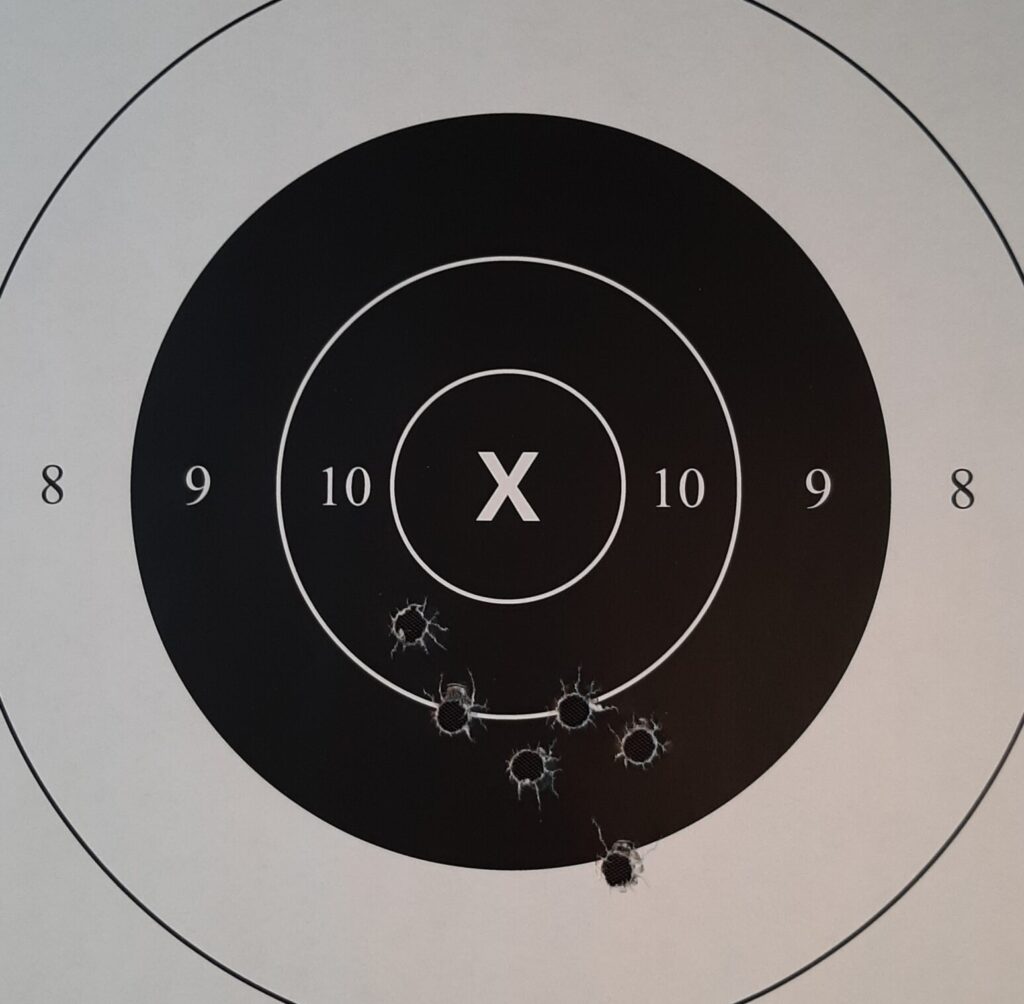
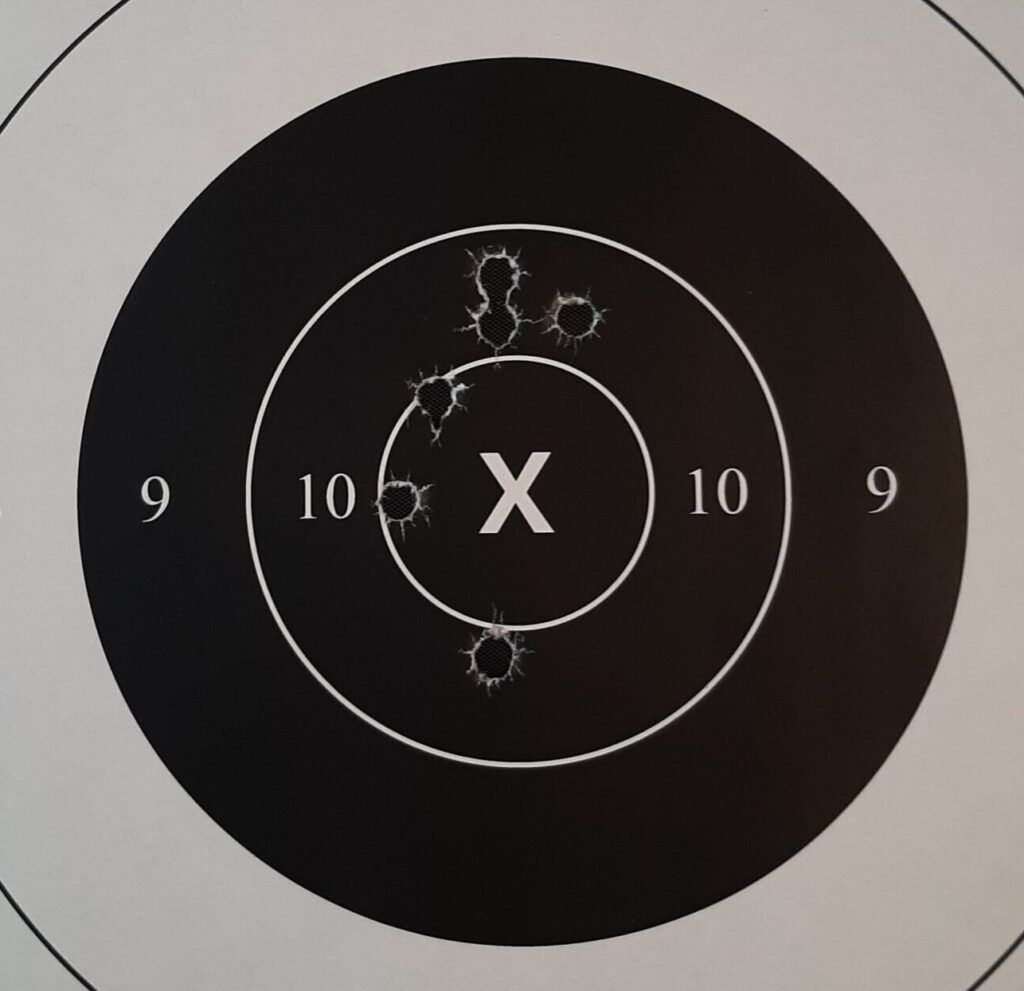
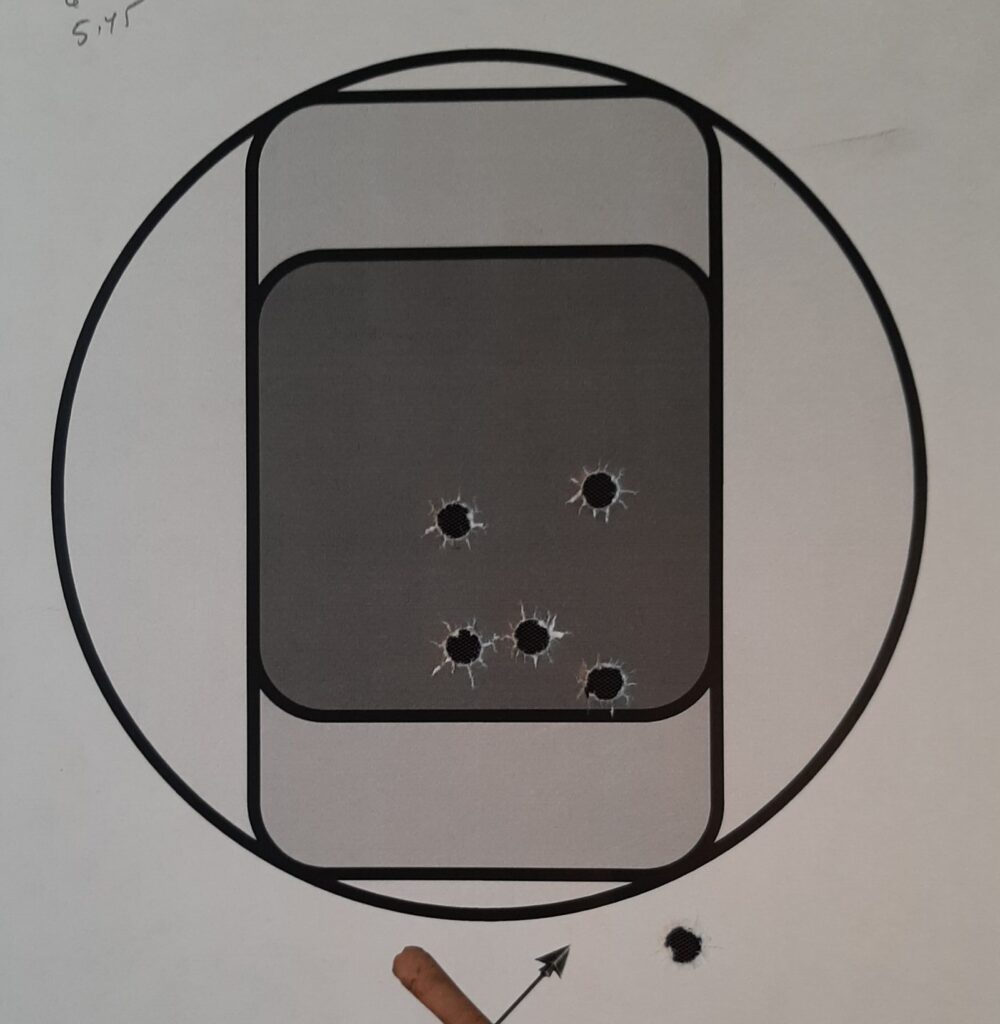
I counted off 25 paces and fired six 125 +P Rem GSHP at a silhouette with an 8-inch circle for a max value zone. Starting at a low ready, I brought the gun up and rolled the trigger as soon as an acceptable sight picture was achieved. The Kimber kept 5 of 6 in the circle, and my trigger press was to blame for the sixth being slightly out. The K6xs reminded me that small guns are less forgiving than full size ones with respect to minor errors in trigger control and sight alignment.
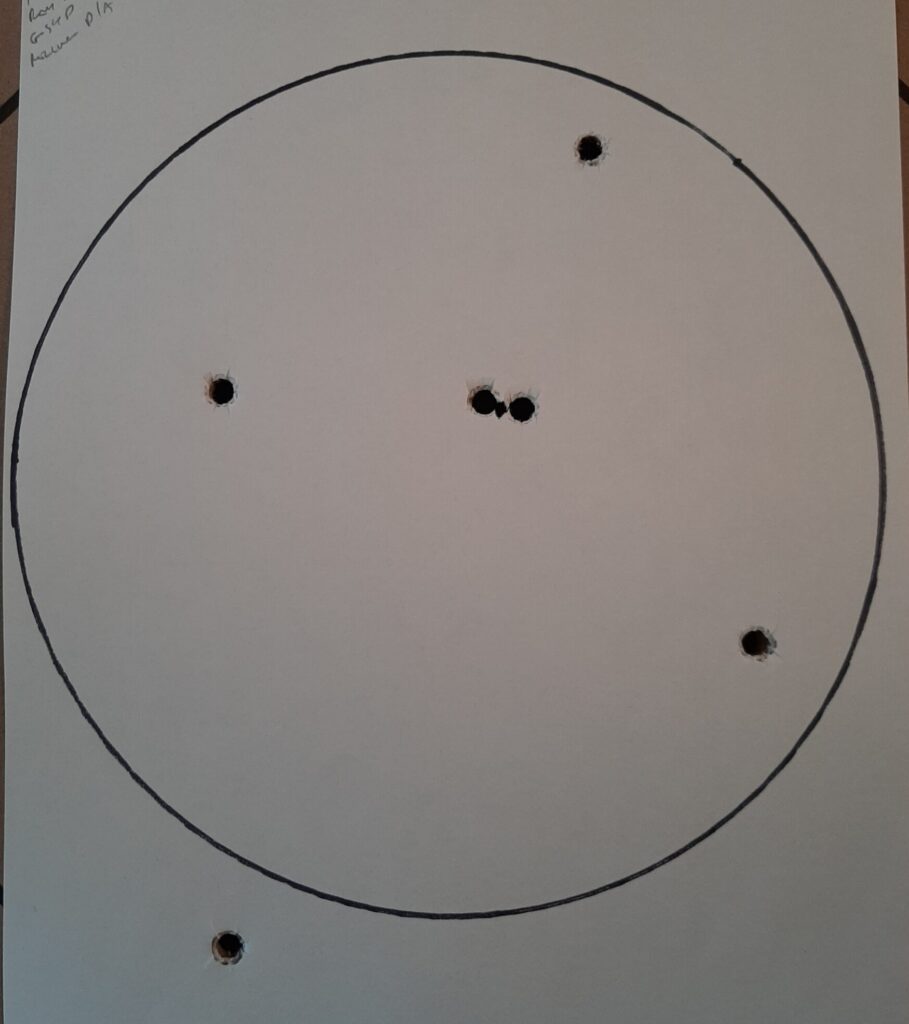
This Kimber will deliver good hits at intermediate ranges (15-25 yards) when the shooter “trusts the force” and smoothly runs the trigger. I fired 95 rounds through the K6xs, 21 of which were +P on that trip. I experienced no trigger finger discomfort, and my shooting hand did not stiffen up. Both K6xs samples gave 100% ignition with all ammunition- factory and hand loads. Extraction and ejection were also 100%, these guns just ran.
Breaking It Down
The K6xs sticks with Kimber tradition when it comes to side plate screws, utilizing hex head screws for this application. It’s a distinct look and prevents conventional screwheads from getting “boogered up”. This often happens when poor fitting screwdrivers are selected for the task, or in moments of carelessness or haste.
Removing the yoke and cylinder revealed the gas check collar was part of the yoke, unlike the removeable collar on the magnum K6. The .38 version is exposed to significantly less pressure and potential gas cutting than the .357 models, it makes sense that it wouldn’t need to be easily replaceable.
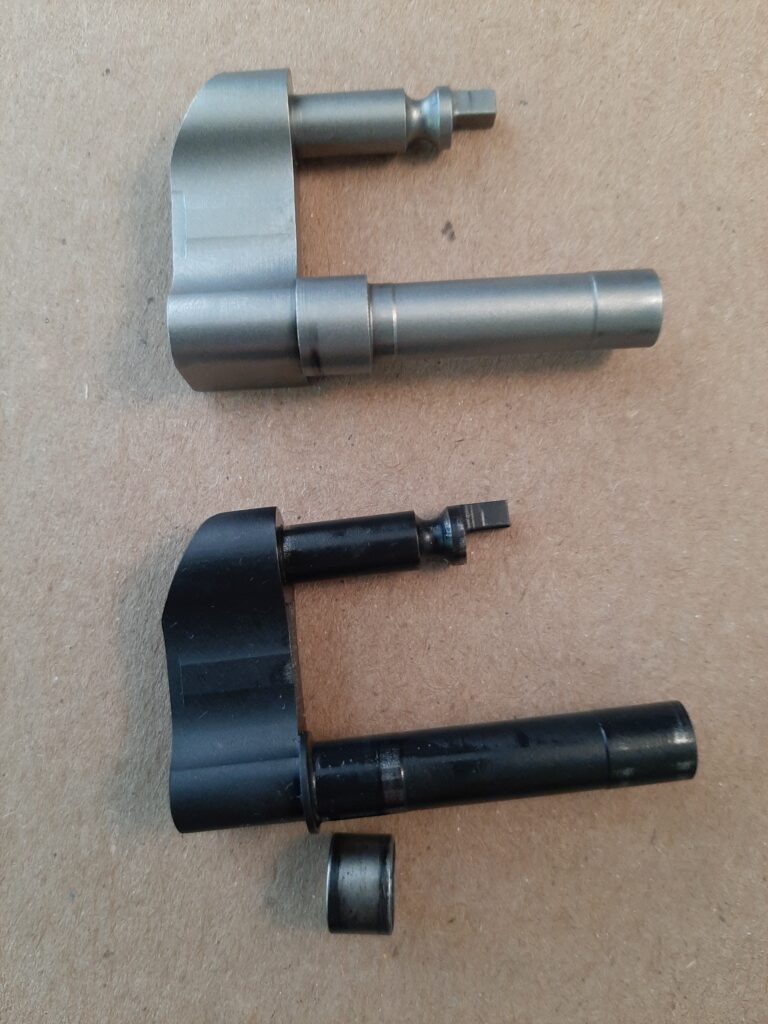
I concur with Kimber’s choice to chamber this alloy framed gun in .38 Special. There are guns made that weigh less than this that are chambered for the .357 Magnum, but very few of those are routinely loaded with magnums- with good reason. The .357 Magnum, ignited in light vessels such as this, will wreck your hands in short order and is nigh on impossible to shoot well with any speed. The all-steel guns in the 23-ounce range should be considered the absolute minimum for torching off magnums, IMHO.
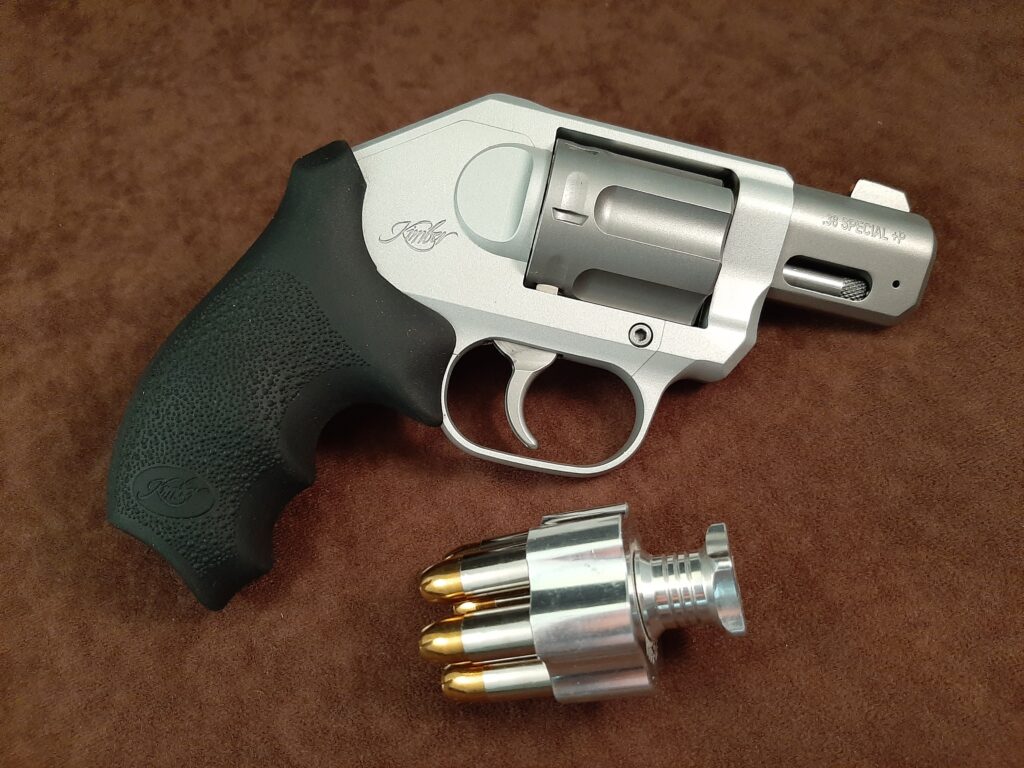
Summing It Up
The K6xs fills the void that was left when the original Colt Cobra and Agent were discontinued. Those guns were chosen by lots of savvy cops back in the day for carrying in plain clothes and off duty. They’re still favored today by many knowledgeable folks for their virtues. The K6xs and the Taurus 856 Ultra Lite are the only lightweight, .35 caliber, six shot snub guns of which I’m aware. Unlike those alloy framed Colts, the K6xs can withstand steady use of +P ammunition. It also sends modern projectiles in the 110-125 grain weight range to the sights at reasonable ranges. Bullets in that weight balance terminal effectiveness and tolerable recoil well in lightweight revolvers.
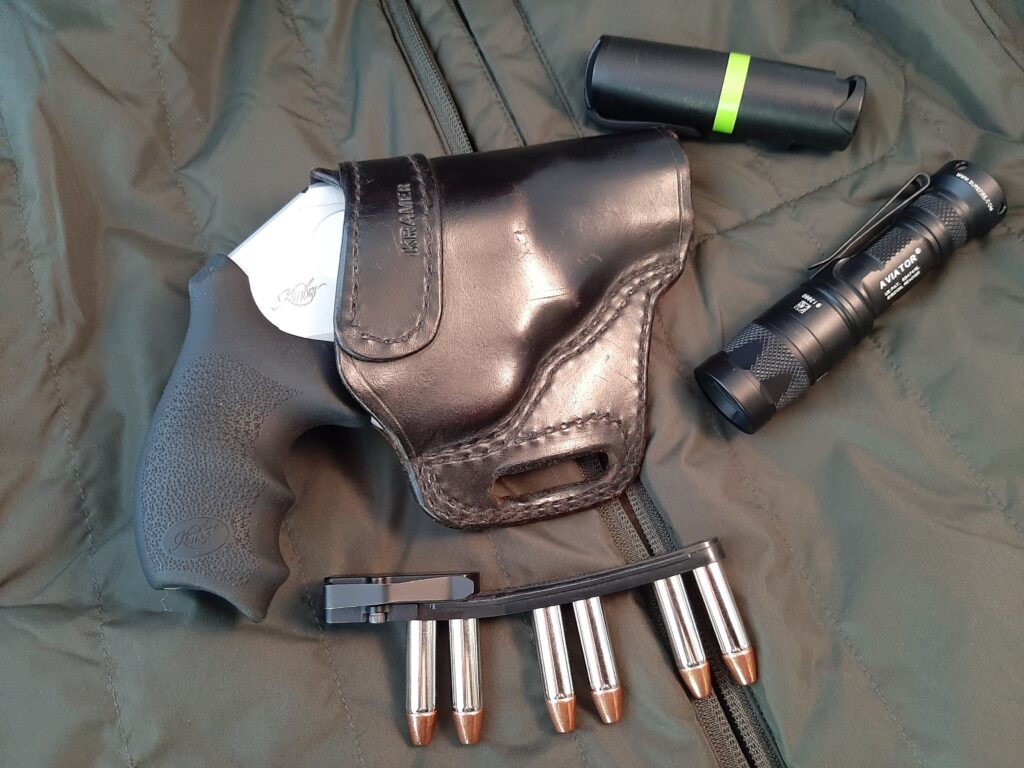
The sight regulation was probably the biggest negative with the original K6; props to Kimber for listening to our gripes and fixing this issue. The sights themselves may not be as good as the K6’s, but they’re well-proportioned and serviceable. Blacking the rear worked satisfactorily with the orange dot front. Before sending Kimber scathing emails about ditching the dovetails, remind yourself that the K6xs retails for 679.00- 300 bucks less than the base K6. For that price Kimber supplies a smooth running, reliable snub revolver that holds six rounds. For many, that extra cartridge on board promotes the K6xs into “primary carry gun territory”, where a five shot revolver would be considered more as a backup. Kimber drew from experience gained building the K6 to provide a lightweight carry revolver that gives precious little to complain about. I believe it was worth the wait.

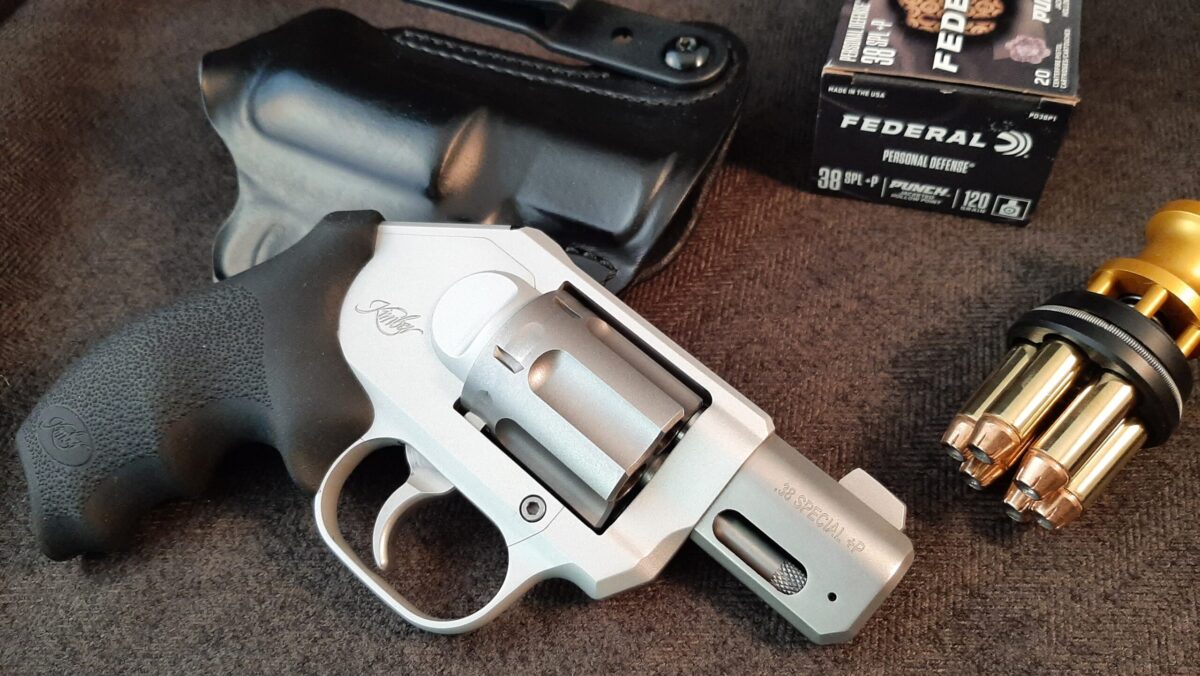
Kevin, thank you for that review. Kimber seems to take that extra step in bringing back ‘old time’ features — countersunk chambers and sights that actually are regulated for the intended POA/POI. I will confess that the geometry of the aft end takes some getting used to. I’m still waiting for one to show up as a rental gun at the local gun ranges in my area – try before you buy.
Back in my day, Colt ran ads for their snub guns (Defective Special, Cobra, Agent) toting that ‘all important sixth shot’ advantage over the S&W Chief’s Special. That notion always seemed to linger – six round duty revolver, six round backup/off duty revolver. The five shot S&W, while smaller and lighter, always seemed to qualify only as a backup. Psychological mind games are alive and well even in the gun industry.
You make an excellent point about power vs weight. Having a .357 Magnum chambering in a flyweight revolver makes no practical sense unless you just have to have a ‘beefier’ built revolver (or concern over a lot of +P .38 Special use). Even then, shooting a full power .357 in teen-weight guns makes touching off a full power .44 Magnum in a S&W Mountain gun seem like nothing.
Maybe a blue / black satin finish will be in the future.
You’re welcome, S. Bond! I agree with your “try before you buy” thought process. Heck, I agree with everything in your comment! If it was a psychological mind game they played on us back in the day, it worked on me. My brain tells me five shooters are back ups and six shooters are primaries. This size gun with an alloy frame with six rounds of .38 Special just makes sense to me. I like it. Let’s hope a black one comes next!
I wonder if they can put a DLC finish on aluminum? They’ve made good use of that coating on the steel guns.
If not, you would think they can use the “Kimpro Black” treatment like they do on semiauto pistols with aluminum frames, and DLC the cylinder and barrel. Hopefully that’s not too far down the road…
I just don’t think I’m interested in a lighter weight version of my K6s. Just something about aluminum I guess? Good article and review and I’m sure that they will sell. I’m a dinosaur in most of my tastes. My Summertime/warm weather carry is either a K6s or an SP101. Cooler weather is a 1911 or a Security Six. Told you I was a dinosaur. Again, good review and I’m enjoying your website.
Thanks Steve, glad you’re enjoying it. I prefer my steel 640 to the lighter 642 with its aluminum frame, but I think we’re in the minority. Most buyers will go for the lighter gun, and, like you, I think these new Kimbers will sell very well.
Thank you, Steve! There’s nothing wrong with being a dinosaur, or your carry hardware choices. I like the option of aluminum framed guns that mirror my steel guns for extended carry, more so as my teeth get longer. Steel guns minimize trauma on your hands if you practice often, and in theory will last longer. The weight of the K6xs weighs my britches down less at the end of a long day then does my K6 though; like subbing a Lightweight Commander for a Government Model. I’m glad you’re getting something out of the website, and golf clap to you for carrying that Security Six!
“The K6xs and the Taurus 856 Ultra Lite are the only .35 caliber, six shot snub guns of which I’m aware.”
I’ve never heard of this mysterious .35 caliber cartridge, is that like the newfangled .30 Super Carry?
J/k, nice review. Seems like it could make for a decent ankle-carry option if that’s your sort of thing.
Ha! That’s just a rounding error, Jeb. The .357 bore wishes it was a true .38, but the Tenths and Hundredths columns tell us it’s a .35. 😁
Thanks, Jeb! I probably could have been clearer with my words there. I was trying to emphasize the fact that the Kimber and Taurus 856 UL were the only lightweight .35’s (.38’s) in the size range that carry six cartridges. Ruger makes a six shot .32 caliber in the LCR, and S&W used to do likewise in a J frame, but you had to drop down to .32 caliber to get six in the cylinder. Colt currently offers its’ new Cobra in a six-shot format, but in an all steel, heavier gun. Most alloy guns in this class only hold 5 if they’re chambered in .38 Special or .357 Magnum. The K6xs & 856 UL are the only lightweight, six shot .38’s around. That makes them both pretty significant. 🙂
Jeb, the .35 caliber connotation has its roots in the 19th Century. The Colt 1851 Navy revolver was perhaps their most prolific cap and ball revolver of the era. The cylinder chambers were about .374” in diameter, because at that time, the ‘caliber’ of a firearms was measured between the lands of the rifling instead of the grooves. So a “.36 caliber” gun had to shoot a slightly larger bullet for the lead projectile to grab the rifling.
When the cap & ball revolver was being loaded, the bullet was swaged into the cylinder get a perfect seal, the bullet itself had to be slightly oversize. So a .36 caliber actually had a .374 bore cylinder which accepted, essentially, .38 bullets. Calling it a .38 was easier than calling it a Three Seventy Four. (Which we now have no issue with a .357 Magnum or .454 Casull, go figure).
Shortly after the war of northern aggression ( 1861-1865 ) there was something of a rush to convert cap & ball Colt 1851 Navy revolvers from using .36 caliber balls to the new self contained metallic .38 Short Colt. This round had the same case diameter as the cylinder chamber, and used a heeled bullet. Think .22 Long Rifle – that uses a heeled bullet that has the same bullet diameter as the case, with a smaller section of the bullet inserted into the case itself. The heeled base also allowed for bullet lube to keep things from getting too messy while shooting.
When the ever slightly more potent .38 Long Colt was developed, the heeled bullet was ditched in favor of a smaller bullet diameter fitting inside the cartridge case and being crimped into place. Said bullet turned out to be .357″. This enabled the grease grooves of the bullet to be on the inside of the case instead of on the exterior of the bullet where dirt and dust bunnies could make nasty.
When the bullet diameter was reduced, the barrel bore dimentions were also reduced and was now a gnat’s hair under .36 measured between the rifling grooves – just like we have today. The name .38 remained for ease of reference since everything started as .38 way back when. The nomenclature was changed back to .357 only with the advent of the .357 Magnum in the mid 1930s.
I suppose you could call the .38 Special a .357 Nitro Express, but we have enough confused people wandering the marketing departments as it is, so .38 Special it is.
Hope that helps.
Wow…
S. Bond, that historical treatise was a pleasure to read, thank you! You are an academic trunk monkey, and I mean that with all respect! 🙂
Early adopter of the K6, both the 2″ and the 3″, they’ve been great guns. When the K6xs came along last July, I bought the first one I saw. love this K6xs. 300 rds through it and it does love the Federal 120gr Punch ammo and shoots it to POA at 15 yds with the Orange dot pulled down to the bottom of the the trench in the rear. Right on the money windage wise, also.
One thing to watch out for and that is the little retaining screw that holds the cylinder release in place. After a recent range session I found that little screw had backed out and was hanging by a thread. A tiny drop of LocTite and a very small .050 Allen wrench and the little screw was secured. I would hate to “have to find one” if it ever fell out. Similar issue with Ruger occurs infrequently.
The new K6xs is my preferred carry piece and the HKS DS speedloaders work like a charm.
Tom
Hey Tom, thank you for a long term user’s perspective. I agree with you- Kimber did a great job with sight regulation on this gun. Federal 120 gr. Punch seems to be custom loaded for it!
Thank you for the tip on that retaining screw, valuable info and a good heads up to keep an eye on it.
I didn’t discuss speedloader compatibility in the article, but probably should have. I had similar positive results with the HKS DS loader, also the Speed Beez and Kimber branded 5 Star (both pictured) made specifically for the K6 cylinder worked well. Nice that there is an acceptable variety of loaders for it. Holsters are starting to catch up, also. Good times!
Thanks for the kind words, Kevin. Glad to hear about success with the 5Star reloaders. Been thinking about buying one for “carry use” as they appear to be all metal.
I’m thinking about the Tulstar RATH IWB rig for the K6 do you have any experience with them?
Always enjoy this blog.
You bet, Tom! The 5 Star is all metal and well made. The only issue with it occurs if you have a lot of HKS loader muscle memory. The knob turns counterclockwise to release rounds; opposite of the HKS loader.
I have no experience with that holster, unfortunately. Maybe some of our readers can weigh in? My favorite AIWB holsters for revolvers this size are Harry’s Holsters and Phlster- I’ve had good luck with both for Taurus 856’s, Ruger LCR’s, and S&W J frames. Phlster isn’t making their City Special for the Kimber yet, Harry’s Masterpiece should be available for the K6xs very soon. I wish I could be more help on that.
I would be interested in buying one of these if I had the money for it. Sadly, I used up all my “Firearms Fund” buying a S&W 586 (not a pre-lock, in case anyone asks).
Not sure how the K6xs compares in a pocket to my 642 or 856. Looks like it’s a bit bigger than the latter, though it’s hard to say.
Hey Axel, you can’t be faulted for committing available funds to a 586. The K6xs is sure worth considering when you fill the piggy bank back up, though. I would defer to Mike on the pocket carry specifics, I rarely use the method, and only with an LCR or 442 when I do. It is slightly larger than a 642, but the concealed hammer makes it like a “856 UL sized” 642, if that helps. If memory serves, you carry a steel 856, so the K6xs would be noticeably lighter in a pocket…
If the K6xs is around the size of 856, then that tells me it shouldn’t have any problem in a pocket.
And yeah, a steel 856 with a factory bobbed hammer is one of the revolvers I like to carry. The weight doesn’t bother me, but there are times when a lighter wheelgun is less noticable.
Kevin I have enjoyed each product review done by you and Mike.
They all done with honesty, with no influence from the industry , the unbiased, un varnished facts and details.
You should both be writing for all of the firearm publications. There are vast numbers of new and seasoned gun folks who would benefit immensely.
You know I am anxiously awaiting your review on the gift that is inbound.
Thank you both for your reviews.
Thanks, Tony, for your kind words. I’m glad you find em fit to read. I look forward to your “The Day” articles here as well. I’m excited to get my hands on that one, too! A long time coming…
I like the looks of the K6. If I needed a new one I would sure look at this. I am a fan of one more round. I have a 642, and 2 Taurus Mdl 617 7 shot 38/357 revolvers with 2″ brl. Also have an alloy frame 7 shot Taurus in 38 Spl only. My EDC is one of the 7 shooters in 357. If I am out of bed, one is in the pocket.
Very nice looking, that K 6 is. Good article, thanks.
Hey pop pop, I’m also a fan of one more round- especially in this size gun. You are one upping my “one more round” guns with those handy 7 shot Taurus revolvers, sir. Thanks for reading it!
Thanks for a great review, Kevin. Clear, informative and unbiased…all in short supply these days. I’ve been curious about the K6XS…I love my K6S and this one looks like a well-sorted tool also. Keep up the good work!
Hey Kevin, you’re welcome! Thank you for the kind words. Kimber did a really good job with the K6xs, a well-sorted tool indeed! Be safe down south, Sir.
I put a few cylinder’s worth through this today during range day at SHOT and was very impressed. I’ve always liked Kimber’s wheelguns, but my experience with them is very limited. Definitely got less beat up than with a 642, and the sights were dead-on with the supplied Barnes ammunition. Curious to see how I’d feel about it with less forgiving grips.
Hopefully I can get my hands on one this year and see what I think long term.
Dan, I shot it for the first time today out there as well. They were issuing Federal ball when I shot it, and the sights were dead on. I hit the half-size silhouette hostage swinger 5/6 with it (distance somewhere around 10-12 yards?) and it was easy stuff. Those grips really did a great job with the recoil, making this gun more friendly to shoot than a 642. I was impressed! They’ve got a winner with this one. I’m so glad they listened to our feedback about sight regulation for this one.
Mike, I’m tickled you finally got the chance to shoot one, too. It’s hard to overstate how nice it is to have the sights properly regulated for contemporary bullet weight fighting ammo! Rock on!
Hey Dan, I’m glad you got a chance to shoot one. The supplied Hogue’s definitely favor shooting comfort over outright concealability. You rightfully point out that grip selection is a major concern with a gun of this weight. The VZ’s on my K6 .357 worked pretty well with a steel gun and mid-range magnums, I suspect they would do likewise on the K6xs with +P’s. Keep your eye on Hamre Forge too, they’re working on some really cool boot grip style grips for the K6xs that are very promising. Keep us posted when you get the chance to wring a K6xs out long term.
Others have suggested that the K6XS is a sensible replacement for our irreplaceable Colt Cobra/Agent or S&W M12 revolvers. It’s a good point; there’s no replacing them should we break them. I was steeling myself against the odd looks of the Kimber by reminding myself “Pretty is as pretty does” and stuffing cash into my Next Gun Fund. Then S&W/Lipsey’s comes along and announced their Ultimate Carry J-frame and I’m back in compare and contrast mode. It’s a good time to be alive…
Michaelb, you make some very good points. The K6xs steps up into that huge void left by the absence of the grand old Cobra and Agents, like a +P rated Centennial version with better sights! If your K6xs gets stolen or damaged, much easier to replace than an old Colt or S&W Model 12. This one is worthy of strong consideration for next gun funding. This SHOT season is proving exactly that, it’s a good time to be alive as a Revolver Guy. Start saving your lunch money!!!
Thanks for a great article!
The Ultimate Carry .32 J, the K6XS, vague rumors of an M12 revival….
Nice to have First World problems. Meanwhile my Cobras, M12 and 856 soldier on.
You’re welcome ViejoLobo, Thanks for reading it!
Yes sir, it seems like the industry is smiling our way a bit right now. I like it! Hopefully Lipsey’s Ultimate Carry J frames will be as successful as we hope and convince S&W that there is a market for them- and for Ultimate Carry K frames- a Model 12 revival, indeed!
Your carry choices are spot on, IMO. I’ve spent a lot of time with some 856’s of late and they have worked really well for me. I’m impressed with what Taurus is doing. It’s nice to have choices, especially when the old Cobra’s and Model 12’s are getting really hard to replace. The K6xs and the 856UL’s do a good job filling that space. Cheers!
FYI; Just letting you know that I recently purchased a Kimber K6xs a month ago and have fired @120 of 38+P through it. I used snaps-caps to dry fire the gun so as not to have a repeat firing-pin problem with the new gun (The K6s I bought back in 2017 firing-pin broke). No such luck. I was loading the gun with snap-caps this evening and the cylinder would not close. Yes, you guess it, the firing-pin is broken and slides freely in and out of it’s hole when the gun is tilted.
Aw crud! That’s not a happy report to receive Jeffrey, but I really appreciate you sharing it with us. It sounds like we’re going to have to monitor for this issue again. Disappointing.
I hope Kimber customer service will get that fixed up quickly for you.
This might be a good time to remind folks that TK Custom is making replacement firing pins for the Kimbers . . . give them a call, and they can set you up. I’d presume the dimensions of the K6xs firing pin are the same as the K6s.
I love my K6s and K6xs. I love the way they look, shoot, feels…. The one thing I don’t like is the Kimber firing-pin. I replaced the K6s with a TK pin and will do the same with the K6xs. I would purchase either or both again. Just have to keep in mind the possibility of a pin problem.
Best, JJK
Jeffrey, I replaced both of mine with TKC parts, and based on your report, would do the same if I had a K6xs. There’s much to like about the gun, but reliable function is the number one attribute of a defensive revolver and must not be compromised.
TK Custom Kimber K6s Firing Pin
Oh, no! I truly hope this is a one off issue with the K6xs, Jeffrey. That’s a total bummer that it has happened to you TWICE. Kimber is aware of the issue, and we thought it was corrected. May they repair it swiftly…
I am not alone here, there is another firing-pin break with a K6xs talked about at Buds Guns in the “community” section.
Jeffrey, I’m curious . . . Can you try seeing if the firing pin will stick to a magnet? I’m wondering if it’s steel, or if they went back to trying Titanium again.
Good thinking, I tried a magnet and it will not make the pin piece move. Tried a few times and the magnet can even push the broken end back in the hole it which it lives (LOL). It is not steel. Now, did they go back to Titanium or did an old batch some how end up in the manufacturing?
I am not alone here, there is another firing-pin break with a K6xs talked about at Buds Guns in the “community” section.
That would confirm my suspicion. If it won’t stick to a magnet, then it’s possibly a Titanium part. We’ve been down this road already.
Well, good news and bad news . . .
Kimber contacts report the firing pins on the K6xs revolvers are steel, not Titanium. That’s the good news, I suppose.
The bad news is that there’s still a problem, if some guns are breaking. A bad batch of parts? A stress riser from a manufacturing process, or a weakness in the design? Not sure, but we’ve asked them to look into it, and will keep you posted if we learn anything.
In the meantime, I’m confident Kimber Customer Service will quickly take care of the folks who have their guns break. Give them a call, and they’ll get you squared away.
I encourage readers to give us their feedback if they encounter this issue with their own gun. The more data we have, the better we can understand the scope of the problem. I hope these two reports are just rare exceptions, not indicators of a larger trend, but we won’t know for sure unless we get better data and information.
Thank you Jeffrey, for the update on the composition of that firing pin. Also for letting us and our readers know to be aware of the potential issue. I agree, there is a lot to like with all of Kimber’s revolvers. Let’s hope they can fix this one for good this time.
I’d love to see Kimber flesh out their revolver line-up with a 7 shot 32H&R K6xs and a 7shot 327mag K6.
While they’re at it an 8 or 10 shot .22LR K6xs would be just fine.
Love this website and long live the revolver revival 🙂
Great suggestions Patrick! I think the new Lipsey’s / S&W 432UC and 632UC revolvers, the new Taurus 327 T.O.R.O., and even the well-established Ruger LCRs and SP101s, will reignite a lot of interest in the .32s in the coming year. Manufacturers like Remington and Federal are already gearing up to make more ammo in this caliber in 2024, as well. You might get your wish if Kimber sees 2024 turn into “The Year of the .32” and figures there’s a strong market for .32 caliber versions of their K6-series guns.
Patrick, I like the way your brain works, Sir! It would be interesting to see if Kimber’s engineers could pull off the 7 shot cylinders in the space they have to work with. Rimfire versions would be a welcome addition, too. Good call!
I was really eager to try one of these out. That firing pin issue doesn’t inspire a lot of confidence.
Shane, it’s the one negative in a pile of positives. I wouldn’t let it scare me away. If you buy one, something to keep an eye on, or if its a deal breaker you can order the TK Custom replacement assembly. I still have access to a K6xs, I’ll dry fire it (with snap caps) a whole bunch. I will let you guys know if it fails.
Thanks, Kevin. I have been considering upgrading my 442’s to the new Ultra Carry model or this Kimber. The extra round had me leaning towards the Kimber. Do you know if one of the Jet Loader models works with the K6?
Hey Shane, I don’t own a Jet Loader for a K Frame, but I’ve had that same thought about trying one in a K6xs. My guess is it will be troublesome, based on the sketchy results I’ve had with Safariland Comp III’s with the K6 series. The K6 specific Speed Beez loader works great, just don’t drop it or you’ll be using Claude Werner methods for single loading loose rounds. I guess we need to start an email campaign in hopes of Jet Loader doing us a solid with a K6 model…
I don’t know how much we should allow available speedloaders available for a particular gun influence our decision towards which one we purchase, but if there was a Jetlaoder available for the K6xs it would drift my decision a little more in that direction. lol I practice the Werner method, but have never had need of it with a Jetloader. 🙂
An email campaign sounds good to me. 👍
Well, my LGS had one of these K6xs in stock and I snagged it. I am very impressed thus far! Even if I have to change out the firing pin I think its a win. In fact, I am going to get four of them—two to carry, one in the safe for a backup in case one goes down and needs to go back to Kimber, and one for my wife. I did not think there was a small lite revolver that could have made me make a move from the J-frames, but Kimber has done it! Now, to get Jet Loader to make some of their loaders for this Kimber and I am set. 😄
Way to go, Shane! I’m glad you picked one up and I don’t think you’ll regret it. Having back up(s) is an excellent plan. My wife shot the one I was evaluating, and it got the nod of approval from her. She shot it very well, too. If Jet Loader would oblige us on that K6 loader, it would likely function with the Taurus 856 and maybe even the Colt D frames. That would rock and I plan to assist you in this campaign. What say you, Jet Loader?
That’s a good point about a JL for a K6 may also work for the 856 and Colts. They are missing a lot of the market not having one for the 856’s as popular as they are. Hopefully, they will consider this and get production going for these 6 shooters.
The Kimber carries like a backup but feels like a duty-size gun in the hand. It inspires a little more confidence to take to the fight.
Check with 5 star for speed loaders. They show one made for the k6s, and it might fit the k6xs, or, they might make one for it. I currently carry an 856, but the kimber is on the short list.
Hey Stretchman, I can confirm that the 5 Star for the K6 works fine with the K6xs. It works well with the 856, too!
Unfortunately, I heard back from Pistoleer that they have no plans to make a Jet Loader for the K6.
Shane, that’s a bummer piece of news from Pistoleer. I’m going to make them tell me “No”, too-it seems like they are missing a big chunk of sales that the Kimber/Taurus/Colt faithful would contribute. I agree with you 100% on the space that the Kimber (like the 856) fills. That sixth round in a gun that you can hide is huge for me.
Great article and I love the site. Discovered it when I read your history of the K frame.
So I really like these Kimbers…my concern is quality of control and customer service from Kimber. I have been reading horror stories about there 1911s and a few other semi-autos of late. This makes me concerned about investing in a Kimber
Tom, there’s a lot of satisfied Kimber revolver owners that comment here at RevolverGuy, and we’ve done a lot of work with them, ourselves. It’s easy to get spooked by horror stories and rumors on the internet, but I don’t think Kimber has a disproportionate amount of problems, compared to other brands. They all turn out a bad gun from time to time, but my experience has been that Kimber Customer Service will do a good job correcting things for you, if you ever encounter a problem.
Hey Tom, thanks for reading it! I would echo what Mike said about Kimber’s quality control and customer service. Greg Ellifritz has commented that he hasn’t seen any problems with Kimber revolvers in his classes. That’s a good testimonial. I have seen Kimber take a lot of criticism about its autos, but I have not had that experience with its 1911’s. I have owned several, a few of which were carried and shot a whole bunch. They have worked well for me; I have trusted them in some dark places and would do so again.
Based on this report and various reviews, I picked up a Kimber K6xs to go along with my K6S 3″. The K6xs will replace my S&W 642 for pocket and warm weather carry. (The K6S is a bit big for pocket carry, and lives in my beautiful MD Whitefield Custom Leather OWB holster.) Both are loaded with Federal Target 148g wadcutters.
Fit and finish are excellent, just like the K6S, and I certainly won’t miss the 642’s horrible trigger! However, the trigger on the K6xs is different that on the K6S. While the larger revolver has a wonderful, smooth trigger pull of reasonable weight, the K6xs has a very definite step between cylinder lockup and release. It is almost like a hard stop after staging that takes a conscious effort to go beyond. Mind you, this is only after a couple hundred snap-cap dry fires and no live ammunition. But it hasn’t seemed to change.
I’ve read that the linkage is changed bit for compactness and that might contribute. But that was someone’s opinion, not from Kimber. It is not objectionable, and still much better than the 642. Just not as good as the wonderful trigger pull on the K6S.
My dealer only had one in stock, so I couldn’t compare, and didn’t allow dry firing anyway. No one else around has one available, and I’m now beyond my return date, anyway. I’d briefly considered returning it, but as noted, it is still a huge improvement on the 642.
I realize this thread post is several months old, so most won’t see it. But is anyone else seeing a noticeable difference between the trigger pull on the K6S vs. K6xs? I’m hoping that this is “as designed” to put my mind at ease. But I know that if it turns into a problem, Kimber customer service will take care of it.
Thanks for the great article, and for another fine recommendation!
Steve, I’m glad you found the information here was helpful, and I’m also glad you’re enjoying your new Kimber so much.
I don’t have a K6xs, but was able to do some limited shooting with one in January, at SHOT. I don’t remember experiencing the feel that you’re describing on the sample I shot, which had a smooth trigger throughout the press. I’m sure Kevin will be able to weigh in with more authority, as we had our sample shipped to him for testing, and he had access to a second sample, as well. He’s done much more shooting with the guns and will be able to give you a better idea if yours is like the rest.
I’m suspicious of the explanation that the action has been changed due to the more compact format. Any shrinking of the K6xs probably occurred well forward of the action. The cylinder window and frame are a little shorter for the .38 Special, but I think it’s unlikely the back end of the gun was substantially changed.
To me, what you’re describing sounds like some kind of fit issue between the hand and ratchet. Perhaps one or the other is a little proud, or a little rough, and you’re feeling it at lockup. It’s possible the interaction between the trigger and sear is a little rough as well. I’d expect either of these to improve as you continue to shoot and dry press the gun, but if they bother you, I’m sure Kimber customer service can square it away.
Hey Steve, Thank you for your kind words on the article- I’m glad you got something out of it! I suspect Mike’s long distance diagnosis of your action is on the money. I think sometimes guns go leave the factory with actions that are “within specs” but not as smooth as we would expect. I love my K6, but you described the action on it perfectly. Mine now has a lot of rounds through it, and I decided to get the spring kit when I upgraded the firing pin with TK Custom parts. Everything eventually settled down internally and the action on it is decent now. Everybody was raving about how good the K6 action was when they came out, but I wasn’t feeling it! The action on the K6xs I got to test was actually that good out of the box, so I dont think it’s model specific. I would be patient with it, If it doesn’t work itself out, I bet Kimber will make it right. Good luck!
Thank you Kevin and Mike.
I too wondered about the different linkage claim, and chalk it up to some random internet expert’s unfounded opinion.
I have the TK Custom parts for my K6S, but haven’t opened it to swap them out. I’ll continue exercising the K6xs to see if there’s any improvement, but as I mentioned, it still functions fine; just not quite as well as the K6S. I don’t want to open it up, in case I have to send it in if it gets worse (which I don’t expect.)
I’ve got a Simply Rugged pocket holster and an Alabama Holsters Kydex version on order for pocket carry (Another fine article from early January!) But right now it is in an old floppy Blackhawk #4 from my S&W 642. I’ve been meaning to replace that pocket holster for a while, and the new K6xs is a great excuse!
Thanks again!
That’s a good report to hear, Steve. That K6xs deserves the good holster investment you’re making! Keep us posted!
I finally made it out to shoot my K6xs. Overall, I love it! I definitely have some work to do to get where I need to get with it, but hey, that’s fun. I noticed my 130 grain training loads hit 3-4 inches high. My 110 carry rounds hit right where I wanted them to.
I’m glad you’re enjoying the gun, Shane. It’s interesting that your lightweight loads hit to POA—it seems to reaffirm Kevin’s experience, and indicate that maybe Kimber used the lighter bullets to regulate the sights on these aluminum guns, instrad of going to the middleweights.
I should add that there were no broken firing pins out of either of the two K6xs I was shooting—time will tell as I plan on running them hard and often!
Excellent, please keep us posted!
Very cool, Shane. I was very pleased that the K6xs hit to point of aim with 110 and 125 grain defensive loads. I had good luck using commercial 125 TMJ loads and handloads with a 125 gr coated RNFP for practice. I like the bullet weight choice that Kimber made with this one! Keep running em, man!
As far as broken firing pins go, is this happening primarily in dry-practice without snap caps, or in live fire, or both?
Shane, from what I recall, dryfire without snap caps was the biggest culprit with the original K6 guns. I don’t have that officially, but that was the buzz at the time it was happening. It’s a good habit to get into though, using snap caps for dry work and regular function checks/FP inspections. We should probably be doing that with ALL of our carry revolvers…
Thanks Kevin. I always use snap caps in my dry-practice, so hopefully I’ll be ok.
Kevin, It is best to use the Snap Caps that have a spring inside. I had a pin break on the K6xs while using the snap caps that have the gummy substance in the primer hole. Seems the primer area indented and cause the pin to meet less and less resistance (which equates to the same as firing on an empty chamber) and farther travel distance of the pin. The two pins that broke in both the K6 and K6xs broke near the flare of the pin at the rear which was larger than the hole entering the chamber area which resulted in the pins sliding back and forth but not falling out. (Hope this is not clear as mud)
Best, Jeff
Very useful info, Jeff. Thanks a million for sharing it. I can see where a break at that point would retain the forward portion of the pin in the frame.